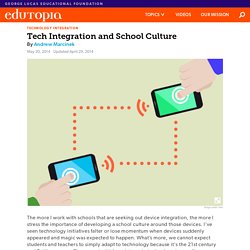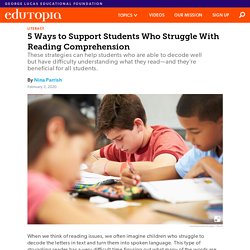

Technology Integration Research Review: Annotated Bibliography. Arena, D.A. (2012).

Commercial Video Games as Preparation for Future Learning [Abstract]. Stanford University, Stanford, CA. Doctoral dissertation, presented at the Games for Learning Conference, in the session on "Games in Schools," June 2012. In a randomized-control experiment, community-college students were assigned to one of three conditions: to play the video game Civilization for as much as 15 hours over five weeks, to play Call of Duty for as much as 15 hours over five weeks, or to play no game. All participants took a pretest which indicated no significant differences in their history knowledge. Arici, A. (2008). Bai, H., Pan, W., Hirumi, A., and Kebritchi, M. (2012). > Assessing the Effectiveness of a 3D Instructional Game on Improving Mathematics Achievement and Motivation of Middle School Students [Abstract].
Tech Integration and School Culture. Technology can be a great addition to any school, but it can also be a logistical nightmare if added too quickly and not planned effectively.

In my experience of consulting with school leaders, working in the classroom and designing several large-scale technology initiatives, I've learned many pieces of this puzzle. In this post, I'll outline three important pieces that every school leader should consider before devices enter the school. Develop a Culture of Trust and Openness Every district-wide and building-based administrator should develop a strong relationship with his or her technology director and network manager.
Additionally, school admin should seek out tech directors who not only understand the server room, but who can also be empathetic and understanding about what classroom teachers need. Ultimately, technology should not get in the way of or inhibit classroom practice. Embrace Risk and Promote Innovative Practice Schedule PD That Allows Time to Explore and Share. How to Effectively Use Grades. Grades can wield enormous power over students.

Course grades can influence students’ self-esteem and self-worth and impact how they understand their own identity. Grades can also be influential in admissions processes that have a long-term impact on a student’s trajectory. Other fields that face similar challenges can offer guidance for best practices about grading. In particular, test validity studies offer a useful framework to formatively assess our grading methods. Consider Grade Validity Creating a meaningful grade is difficult. This challenge is not unique to education. Educators already employ a variety of strategies to alleviate grade validity concerns, but psychometrics offers some insights that may further strengthen these efforts. Define the meaning: The first step to improving validity is defining a grade’s intended meaning. To help decide the meaning of your grade, ask yourself who are your primary stakeholders, and how will they use it? 5 Ways to Support Students Who Struggle With Reading Comprehension.
When we think of reading issues, we often imagine children who struggle to decode the letters in text and turn them into spoken language.

This type of struggling reader has a very difficult time figuring out what many of the words are and has poor phonological (speech-sound) skills. However, there are also many students who sound like they’re reading beautifully but have difficulty with understanding vocabulary and figurative language, inferencing, verbal reasoning, grammatical development, and oral expression. As children get older, if they are decoding text well we assume they are reading well. Once a person learns to decode, reading comprehension becomes more about language comprehension and focus. At this transition, starting around third grade, teachers may begin to notice some students who decode text fluently but are not understanding. These struggling readers should be targeted for remediation—the earlier the better. Supporting Students Who Struggle With Comprehension 1. 3 Reasons Students Procrastinate—and How to Help Them Stop.
Leonardo da Vinci spent nearly 16 years painting the Mona Lisa—and never completed it.

The Hitchhiker’s Guide to the Galaxy author Douglas Adams famously wrote, “I love deadlines. I love the whooshing noise they make as they go by.” And Frank Lloyd Wright spent a mere two hours designing Fallingwater—after delaying for nine months. “Procrastination is extremely prevalent,” Piers Steel, a business professor at the University of Calgary, noted in a 2007 study. “Estimates indicate that 80 to 95 percent of college students engage in procrastination, approximately 75 percent consider themselves procrastinators, and almost 50 percent procrastinate consistently and problematically.” If you’re a middle or high school teacher, it’s likely that you have procrastinators in your class—students who consistently wait until the last minute to turn in their assignments, or put off studying until the night before a test. 5 Ways to Encourage Students Not to Procrastinate 1.
The takeaway for teachers? 2.